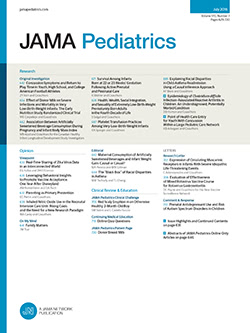全球19岁以下儿童和青少年高血压患病率
IF 18
1区 医学
Q1 PEDIATRICS
引用次数: 0
摘要
小儿高血压可预测成人高血压和早期靶器官损害,但基于不同诊断原则的全球患病率估计仍然很少。目的根据不同的诊断原则估计全球儿童高血压患病率。数据来源包括PubMed、Web of Science、Embase、中国知网(CNKI)、万方数据库等数据库,从建站到2024年7月7日进行了系统检索。研究选择纳入对19岁以下儿童和青少年的原始调查,代表一般人群,并提供高血压患病率的数据。数据的提取与合成数据的筛选与提取由2位作者独立完成。采用随机效应模型估计患病率。对时间趋势以及区域和人口差异进行了探讨。进行亚组分析和元回归分析以确定异质性的来源。采用漏斗图和Egger检验评估发表偏倚。主要结局和测量主要结局是儿童高血压,分为持续性高血压(持续诊断确诊≥3次)和偶发性高血压(首次诊断由单次筛查时的血压测量确定)。结果共纳入271项研究,包括16 328例持续性高血压患者、538 735例偶发性高血压患者和3 609 665例儿童和青少年。持续高血压的全球儿童高血压患病率为3.89% (95% CI, 3.27%-4.62%),偶发性高血压的全球儿童高血压患病率为11.85% (95% CI, 10.98%-12.75%)。随着时间的推移,观察到增加的趋势,每年增加7.20% (95% CI, 4.16%-10.32%;P, amp;肝移植;2006年至2021年间,持续性高血压的发病率为0.001),而1987年至2022年间,偶发性高血压的发病率估计每年变化0.33% (95% CI, 0.10%-0.56%)。此外,儿童高血压患病率的地理区域和人口特征也存在显著差异。肥胖或超重的儿童和青少年(持续高血压的16.35%和6.79% vs 2.57%[正常体重])的高血压患病率明显更高。结论和相关性:本系统综述和荟萃分析表明,全球持续性和偶发性高血压患病率存在显著差异,强调了在多个场合测量以提高可靠性的重要性。不同个体的体重指数患病率存在显著差异,这突出表明有必要采取有针对性的干预措施,促进健康的生活方式。本文章由计算机程序翻译,如有差异,请以英文原文为准。
Global Prevalence of Hypertension in Children and Adolescents Younger Than 19 Years
ImportancePediatric hypertension predicts adult hypertension and early target organ damage, yet global prevalence estimates based on different diagnostic principles remain scarce.ObjectiveTo estimate global pediatric hypertension prevalence according to different diagnostic principles.Data SourcesSeveral databases, including PubMed, Web of Science, Embase, the China National Knowledge Infrastructure (CNKI), and the Wanfang Database, were systematically searched from inception to July 7, 2024.Study SelectionStudies were included if they were original investigations in children and adolescents younger than 19 years, represented the general population, and provided data on hypertension prevalence.Data Extraction and SynthesisData screening and extraction were performed independently by 2 authors. A random-effects model was used to estimate prevalence. Temporal trends, as well as regional and population differences, were explored. Subgroup analyses and meta-regression analyses were performed to identify sources of heterogeneity. Publication bias was assessed by funnel plots and the Egger test.Main Outcomes and MeasuresThe primary outcome was pediatric hypertension, categorized into sustained hypertension (persistent diagnosis confirmed on ≥3 separate occasions) and occasional hypertension (initial diagnosis determined by blood pressure measurements on a single screening visit).ResultsA total of 271 studies involving 16 328 individuals with sustained hypertension, 538 735 individuals with occasional hypertension, and 3 609 665 children and adolescents were included for analysis. The global prevalence of pediatric hypertension was 3.89% (95% CI, 3.27%-4.62%) for sustained hypertension and 11.85% (95% CI, 10.98%-12.75%) for occasional hypertension. Increasing trends with time were observed, with an annual increase of 7.20% (95% CI, 4.16%-10.32%; P < .001) from 2006 to 2021 for sustained hypertension and an estimated annual percentage change of 0.33% (95% CI, 0.10%-0.56%) between 1987 and 2022 for occasional hypertension. Additionally, significant differences were observed across geographical regions and population characteristics for the prevalence of pediatric hypertension. Children and adolescents with obesity or overweight (16.35% and 6.79% vs 2.57% [normal weight] for sustained hypertension) had significantly higher prevalence of hypertension.Conclusions and RelevanceThis systematic review and meta-analysis indicates substantial variations in the global prevalence of sustained and occasional hypertension, highlighting the importance of measurements on multiple occasions to enhance reliability. Notable differences in prevalence across individuals’ body mass index values highlight the necessity for targeted interventions to promote healthy lifestyles.
求助全文
通过发布文献求助,成功后即可免费获取论文全文。
去求助
来源期刊

JAMA Pediatrics
PEDIATRICS-
CiteScore
31.60
自引率
1.90%
发文量
357
期刊介绍:
JAMA Pediatrics, the oldest continuously published pediatric journal in the US since 1911, is an international peer-reviewed publication and a part of the JAMA Network. Published weekly online and in 12 issues annually, it garners over 8.4 million article views and downloads yearly. All research articles become freely accessible online after 12 months without any author fees, and through the WHO's HINARI program, the online version is accessible to institutions in developing countries.
With a focus on advancing the health of infants, children, and adolescents, JAMA Pediatrics serves as a platform for discussing crucial issues and policies in child and adolescent health care. Leveraging the latest technology, it ensures timely access to information for its readers worldwide.
 求助内容:
求助内容: 应助结果提醒方式:
应助结果提醒方式:


